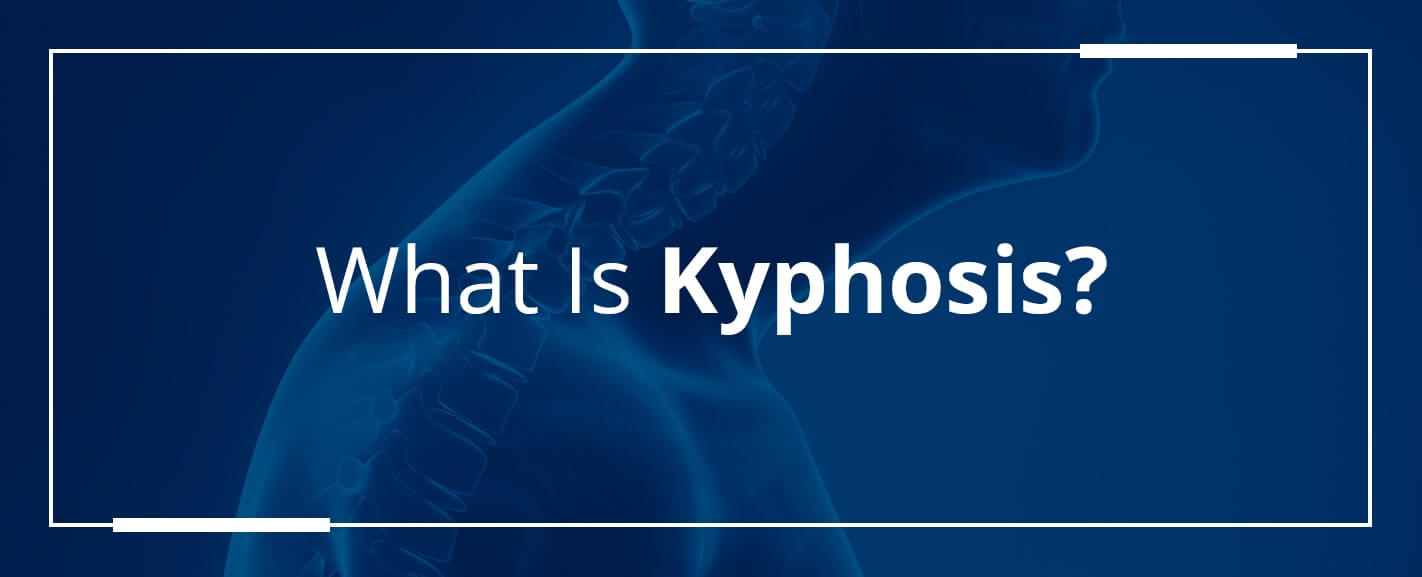
Kyphosis, also known as hyperkyphosis, is an excessive curvature of the spine. While our backs have a natural curve to them of about 20 to 45 degrees, hyperkyphosis exists when the curve in the back is more than a 50-degree angle. Kyphosis causes the upper portion of the back — the thoracic spine — to become excessively rounded.
Patients with kyphosis can develop a hump-like curve to their back and often feel self-conscious about the way they look. When treated early, patients can take steps to reverse their kyphosis symptoms.
Kyphosis is more common in elderly adults, especially women over the age of 55. The abnormal curvature of the back can develop in adolescence and young adulthood. While most cases of kyphosis are not life-threatening, some severe cases can cause difficulty breathing and eating.
Main Types of Kyphosis
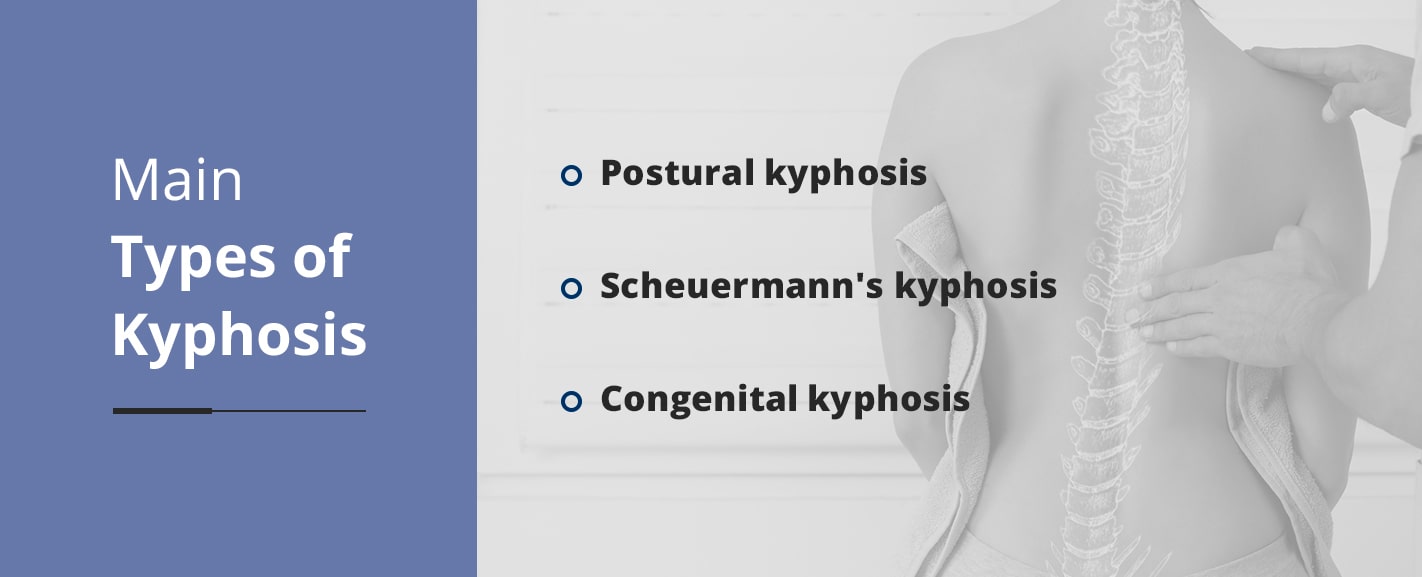
The three most common types of kyphosis are congenital kyphosis, postural kyphosis, and Scheuermann’s kyphosis.
- Postural kyphosis is a treatable, mild type of kyphosis. Teenagers, especially females, develop this type of kyphosis as a result of bad posture. During the early stages of life, the spine is flexible, so with proper exercise, postural kyphosis could be treated. Mostly, postural kyphosis doesn’t cause serious illness or excessive pain.
- Scheuermann’s kyphosis is most common in teenage males. The bones in the spine take on the shape of a wedge, instead of a rectangular shape. As a result, the bones shift forward and cause a rounding of the back. Scheuermann’s kyphosis is more severe than postural kyphosis. While doctors do not know what causes it, the Danish doctor who discovered this type of kyphosis believed that it was a result of poor blood supply during gestation.
- Congenital kyphosis occurs when a child is born with an abnormal curve in the back. Often, the vertebrae of the spine are wedged together. This type of kyphosis will get worse as the child grows, and they will most likely need surgery. Congenital kyphosis occurs at birth because of poor development in the womb.
Causes of Kyphosis
The spine is made up of 24 rectangular bones, or vertebrae, that make up the bone structure between your skull and pelvis. These bones stack on top of each other to support the spine and allow the body to move. The thoracic region of the spine, where kyphosis occurs, comprises 12 of these 24 bones.
Since the spine is fragile, ligaments, in collaboration with spinal muscles, keep your back strong. Everyone naturally has a curve in their spine to provide room for the heart and lungs to pump blood and take in oxygen. Kyphosis occurs when the thoracic region of the back weakens and becomes wedge-shaped, curving the spine more forward than usual.
When a patient starts to experience excessive curvature in the spine, they might start to experience certain symptoms. Depending on the type the patient has, kyphosis is generally caused by:
- Degenerative changes
- Compression fractures
- Muscular weakness
- Altered biomechanics
- Poor posture, especially during childhood and teenage years
- Abnormally shaped vertebrae
- Developmental issues with the spine
- Old age
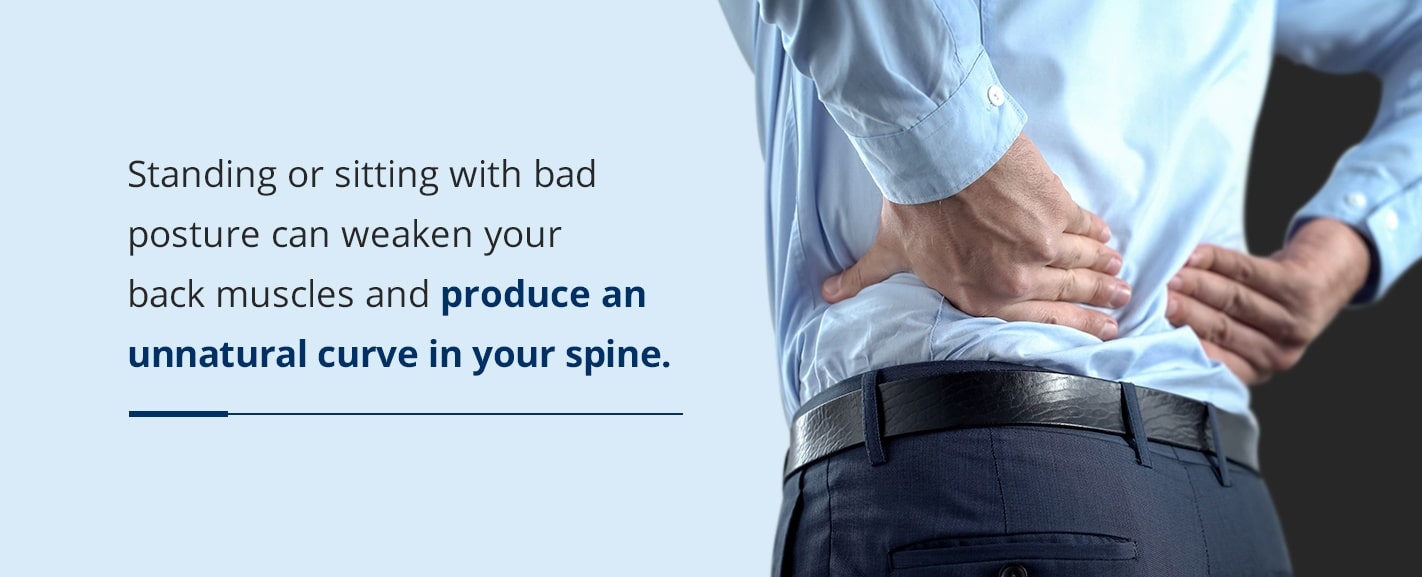
Standing or sitting with bad posture can weaken your back muscles and produce an unnatural curve in your spine. Depending on the type of kyphosis the patient has, it may have been caused by a number of unique factors:
- Postural Kyphosis: The main cause of postural kyphosis is poor posture, especially during childhood. Slouching, carrying heavy backpacks and leaning back in chairs stretch out the ligaments and muscles that make the back strong. These stretched ligaments and muscles pull the thoracic vertebrae into an abnormal position, resulting in postural kyphosis.
- Scheuermann’s Kyphosis: The main cause of Scheuermann’s kyphosis is abnormally shaped vertebrae from birth. Instead of having a rectangular shape, patients with Scheuermann’s kyphosis tend to have triangular-shaped vertebrae. The ligaments around the vertebrae may also be abnormally thick, which typically worsens the patient’s kyphosis symptoms. While we are not sure of what causes Scheuermann’s kyphosis exactly, it does seem to be hereditary. This disorder could also be a result of a disruption in the blood supply to the vertebrae during gestation, which could hinder vertebrae growth.
- Congenital Kyphosis: The main cause of congenital kyphosis is the disruption of development in birth. Congenital kyphosis occurs when vertebrae do not develop properly in the womb. As opposed to Scheuermann’s kyphosis, congenital kyphosis typically results in several vertebrae fusing together.
While they cannot cause kyphosis, certain conditions could worsen symptoms, like:
- Osteoporosis
- Spondylosis
- Spina bifida
- Paget’s disease
- Neurofibromatosis
- Muscular dystrophy
- Tuberculosis
- Spinal cancer
- Spinal injury
Kyphosis Symptoms
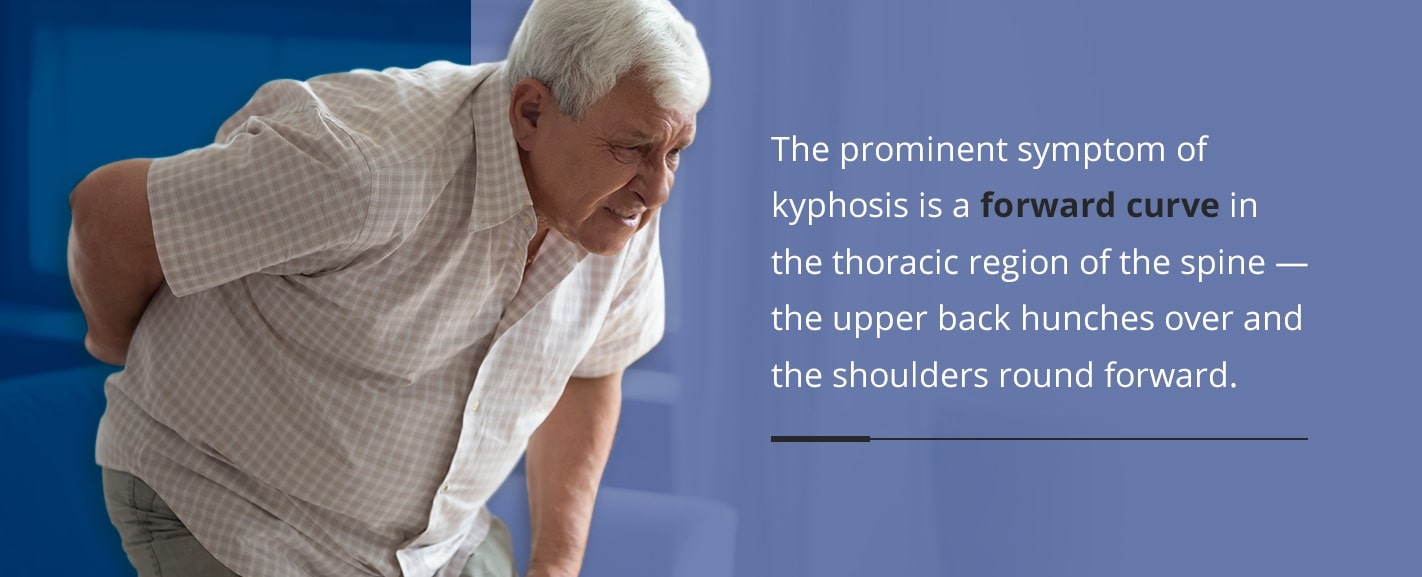
Most people with kyphosis do not exhibit symptoms other than a curvature of the back. However, if you have severe kyphosis, you may eventually have difficulty breathing and eating. Adults with kyphosis are more prone to back pain because the body has to work harder to make up for the spine’s abnormal curvature.
The symptoms a patient exhibits depends on the curve of the back. The prominent symptom of kyphosis is a forward curve in the thoracic region of the spine — the upper back hunches over and the shoulders round forward.
Most often, patients of kyphosis are free of other symptoms, besides an abnormally curved back. Sometimes, kyphosis can cause symptoms such as:
- Back pain
- Back stiffness
- Tenderness of the spine
- Extreme fatigue
- Shoulder pain
- Shoulder stiffness
- Tingling weak, or numb legs
- Difficulty breathing
- Tight hamstrings
- Difficulty eating
When to See a Doctor
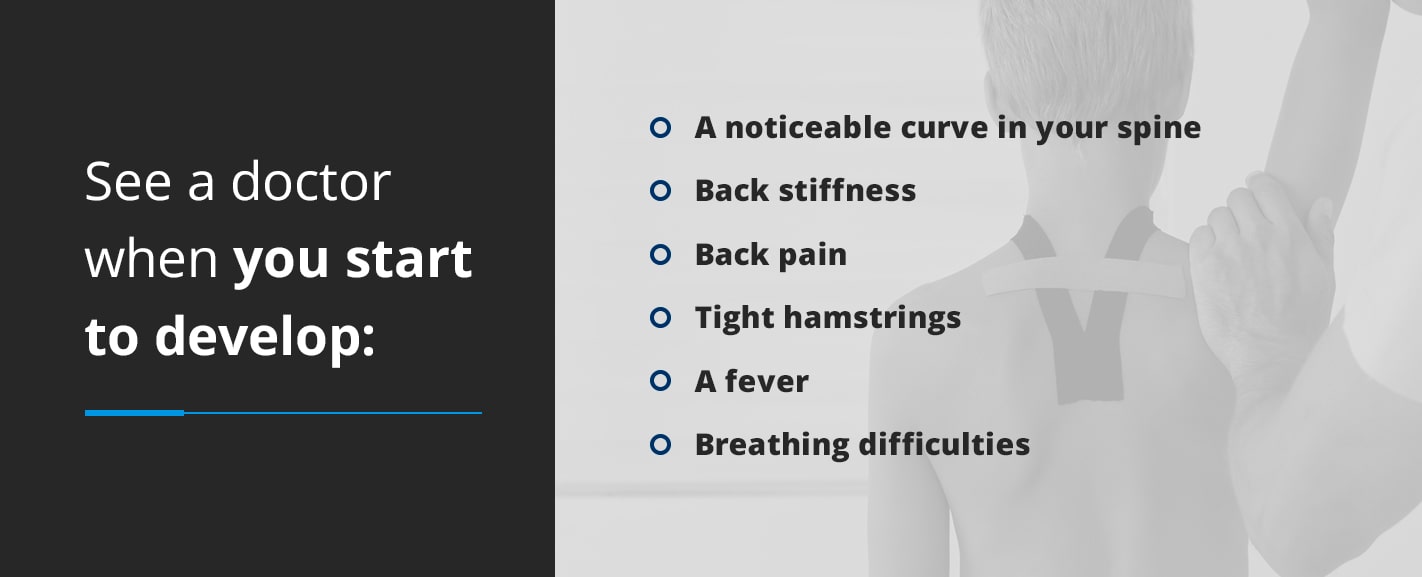
Since the possible symptoms of kyphosis are so broad, it can be challenging to know when a visit to the doctor is necessary. You should consult with a doctor if you start to develop:
- A noticeable curve in your spine
- Back stiffness
- Back pain
- Tight hamstrings
- A fever
- Breathing difficulties
Doctors diagnose kyphosis by conducting a physical exam and investigating the patients’ medical history. Your doctor may ask you a series of questions regarding your symptoms and what could have caused them. In order to reach the most accurate diagnosis, provide your doctor with as much information as possible.
If you experience symptoms of kyphosis, your doctor may ask you to perform several exercises and stretches to assess your balance and range of motion. Doctors can diagnose kyphosis by having patients lie flat on a surface while they examine their spine. If the spine is straight while the patient is lying on the floor, the spine is flexible and is probably curved because of poor posture. If the spine is still curved while the patient is lying on a flat surface, the cause is most likely the structure of the spine.
Doctors usually confirm a kyphosis diagnosis by ordering an x-ray and examining the structure of the vertebrae. The x-ray helps determine the curvature of the spine. While normal spines measure anywhere from 20 to 45 degrees, a patient with kyphosis will have a spine with a curve larger than 50 degrees.
In the diagnosis process, the doctor may check for other conditions that could be related to kyphosis, such as Parkison’s disease. In the case of severe curvature that causes breathing problems for the patient, doctors may order a test to measure the patient’s pulmonary function. If they exhibit symptoms such as tingling, numbness or bladder incontinence, the doctor may order an MRI, or magnetic resonance imaging scan, to inspect the spinal cord.
If your doctor recommends surgery for your treatment, you may be required to undergo further testing, such as a CT, or computerized tomography, scan. If you develop kyphosis as an adult, your doctor may run additional tests to determine what caused you to develop these symptoms, including a blood test to check for infection or a bone density scan to check for osteoporosis.
Kyphosis Treatment
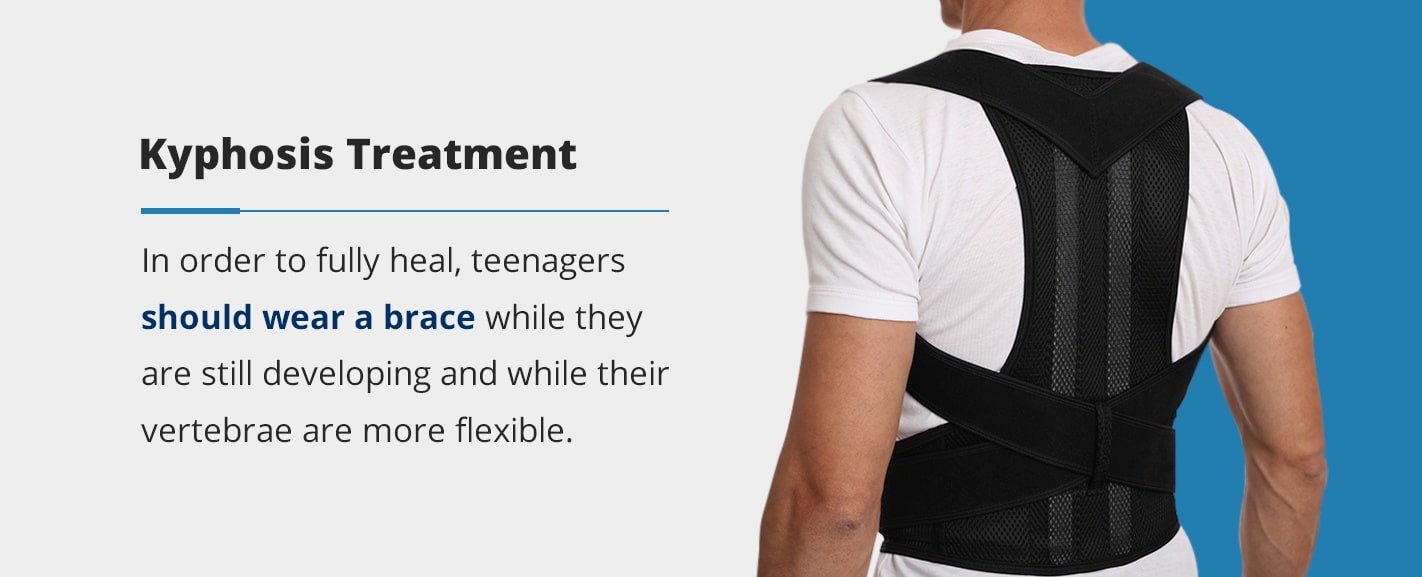
Kyphosis treatment focuses on restoring normal posture and strengthening the spine. While severe kyphosis cases require surgery, most types can be treated without. Postural kyphosis or Scheuermann’s kyphosis with a curve of 75 degrees or less can benefit from non-surgical treatment recommended by a physician.
Often, kyphosis can even be safe for the patient without any treatment, especially if it does not give the patient any painful symptoms. Treatment is dependent on the patient’s medical history, type of kyphosis, age and the extremity of the curve. Doctors will perform scans and physical exams to determine the best course of treatment.
For patients who do not experience severe symptoms, doctors typically recommend certain non-surgical options to fix their patients’ kyphosis, like:
- Monitoring the curve.
- Improving posture by exercising the back and abdominal muscles.
- Attending physical therapy.
- Taking pain medicine, especially non-steroidal anti-inflammatory drugs, or NSAIDs.
- Wearing a back brace, especially during childhood or teenage years.
Since kyphosis usually does not progress after a child has stopped growing, they usually can reverse kyphosis by improving posture. If a child has Scheuermann’s kyphosis, symptoms can be treated depending on:
- The age of the child: Typically, younger children have a higher chance of reversing the effects of kyphosis.
- The sex of the child: Postural kyphosis occurs more in female children than male children, while male children are more likely to have Scheuermann’s kyphosis.
- The abnormality of the spine’s curve: Although an abnormal spine is greater than 50 degrees, any curve greater than 75 degrees is considered significantly abnormal.
- The flexibility of the spine’s curve: Children and teenagers are still developing, so their spines are more flexible.
Teenagers who have kyphosis may find relief from wearing a back brace. In order to fully heal, they should wear the brace while they are still developing and while their vertebrae are more flexible. While wearing a brace may feel restrictive at first, patients with spine disorders typically grow accustomed to them over time. Braces today are created to be convenient, so you can still participate in various physical activities.
If you have severe kyphosis, you might need to consider surgery — it can usually correct the curvature of the spine and relieve back pain, but it comes with a high risk of complications. We would only recommend surgery for kyphosis if:
- Your spinal curve is very pronounced.
- Your pain cannot be controlled with medication.
- Your spinal curve is causing breathing issues or disruptions in the nervous system.
- Your spine will deteriorate further without surgery.
Surgery can significantly reduce your symptoms and give you a better quality of life. To treat abnormal kyphosis, doctors typically use a surgical technique called spinal fusion to decrease symptoms and relieve pain. Spinal fusion is a surgery used to treat kyphosis where the vertebrae curving the spine are joined together.
The surgical procedure takes four to eight hours and typically involves a general anesthetic. During the surgery, the surgeon makes an incision in the back. Then, they use metal rods, screws and hooks to fuse the vertebrae together and straighten the spine.
After the operation, you may be required to stay in the hospital for several days. You may also be required to wear a back brace for a few months after the operation to support your back. You should be able to return to work or school after a few weeks and can resume vigorous physical activity about a year after surgery.
Kyphosis Exercises
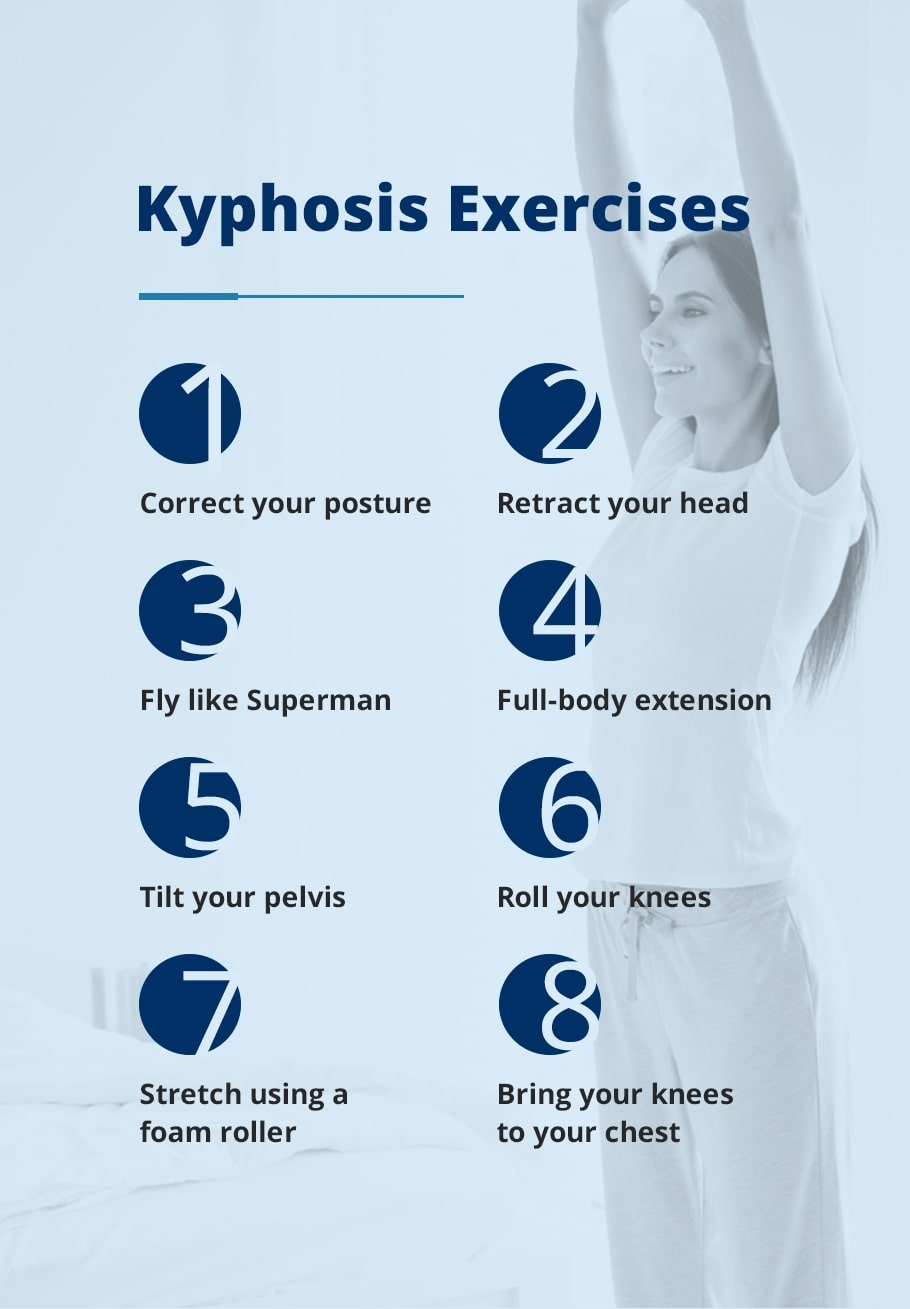
Exercise, along with practicing good posture, is essential for treating kyphosis. Stronger muscles can properly hold your spine according to its correct curvature. Performing these exercises will help you gain strength in your abdominal and back muscles to give your spine the support it needs to maintain good posture.
Before starting exercise, consult with your physician to determine if you have pre-existing medical conditions. If any exercise gives you pain, seek medical help. Some examples of exercises that can help treat Kyphosis symptoms are:
- Correct your posture: Stand as tall as you can, preferably against the wall. If it helps, look in a mirror to determine what you need to do to flex your spine the correct way. Fold your neck so that your chin is near your chest, and your head is in alignment with your shoulders. Hold this posture for at least one minute, unless you feel intense pain. If you feel pain while performing this exercise, you can place your head against a pillow and use the wall to support you.
- Retract your head: Start on the floor with your knees bent and your feet flat on the floor. Bring your chin to your chest and hold the pose. After 15 seconds, lower your head to the floor. Repeat the exercise 10 times.
- Fly like Superman: While lying on your stomach, reach your hands as far as you can in front of you. Bring your arms and legs off the floor, keeping your head in a neutral position and keeping your eyes toward the floor. Hold for three seconds. Repeat ten times.
- Full-body extension: Stand tall, as if someone is pulling on your head. Make a Y with your arms and point your thumbs behind you. While standing in this posture, take a deep breath in through your nose and out through your mouth three times.
- Stretch using a foam roller: Use a foam roller to massage the muscles in the thoracic region of your back. While on the floor, roll the foam roller vertically against your back for at least one minute.
- Roll your knees: Start on the floor with your knees bent and your feet flat on the floor. Move your knees slowly to the left, trying to bring your knee to the floor. When you start feeling a slight pain in your back, start moving your knees to the right, trying to bring your knee to the other side of the floor. Perform this exercise five times on each side.
- Tilt your pelvis: Start on the floor with your knees bent and your feet flat on the floor. Tuck your hands under you onto the small of your back. Slowly push the middle of your back, creating an arch. While doing this exercise, make sure your buttocks, as well as your upper back, stay on the ground. After holding this pose for 15 seconds, bring your back toward the floor again. Repeat this exercise at least five times.
- Bring your knees to your chest: Start on the floor with your knees bent and your feet flat on the floor. Fold your arms around your right knee and gently bring your knee toward the right side of your chest. Keep your knee close to your chest for at least 15 seconds. Slowly release the pose and do the same thing on the other side. Hold this pose at least five times on each leg.
Kyphosis Prevention Tips
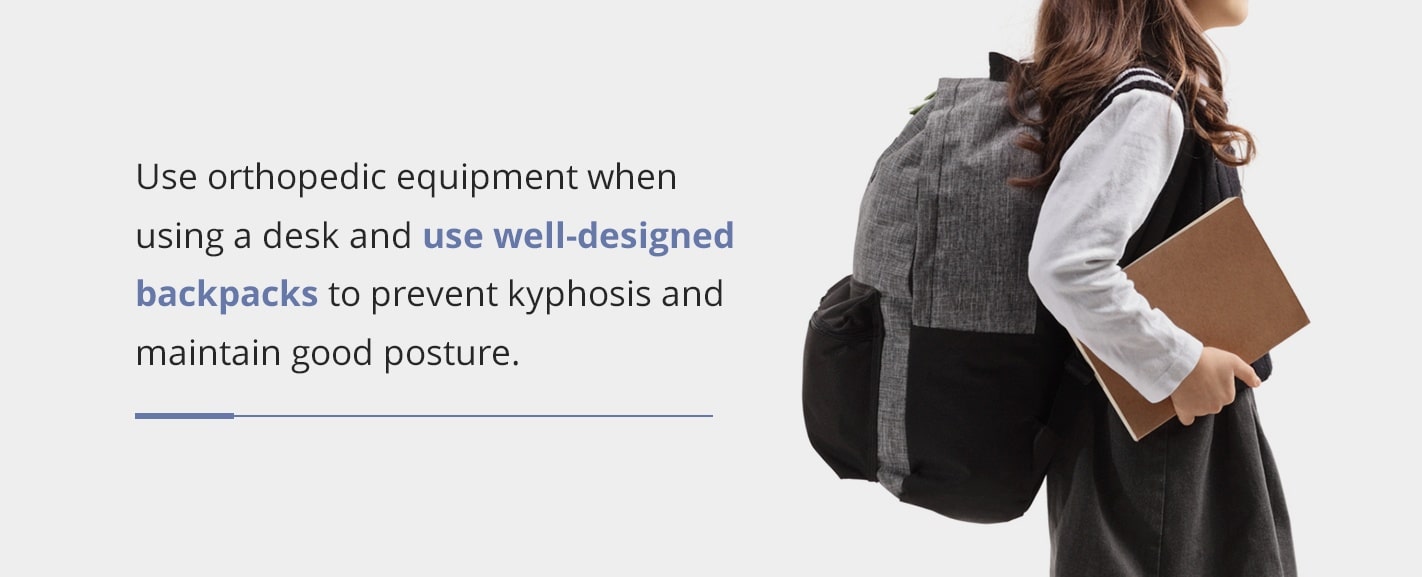
You can prevent postural kyphosis by adjusting your posture, strengthening your abdominal and back muscles and maintaining an ideal body weight. Be aware of how you’re standing or sitting. Sit upright to ensure that the small of your back is supported.
To maintain good posture at all times, try:
- Distributing your weight evenly, keeping your feet shoulder-width apart.
- Keeping your chin level, looking straight ahead.
- Holding your shoulders back.
- Keeping your lower back slightly arched.
Perform abdominal and back exercises to strengthen your back and preserve the flexibility of your spine. Use orthopedic equipment when using a desk and use well-designed backpacks to prevent kyphosis and maintain good posture. Keep your bones healthy and strong by eating calcium-rich foods and other vitamins.
You cannot prevent Scheuermann’s kyphosis or congenital kyphosis from developing because they are caused by structural defects. You can reduce symptoms through exercise and consulting your physician. When you catch kyphosis during its early stages, you are more likely to have success treating your symptoms and a better quality of life.
Complications
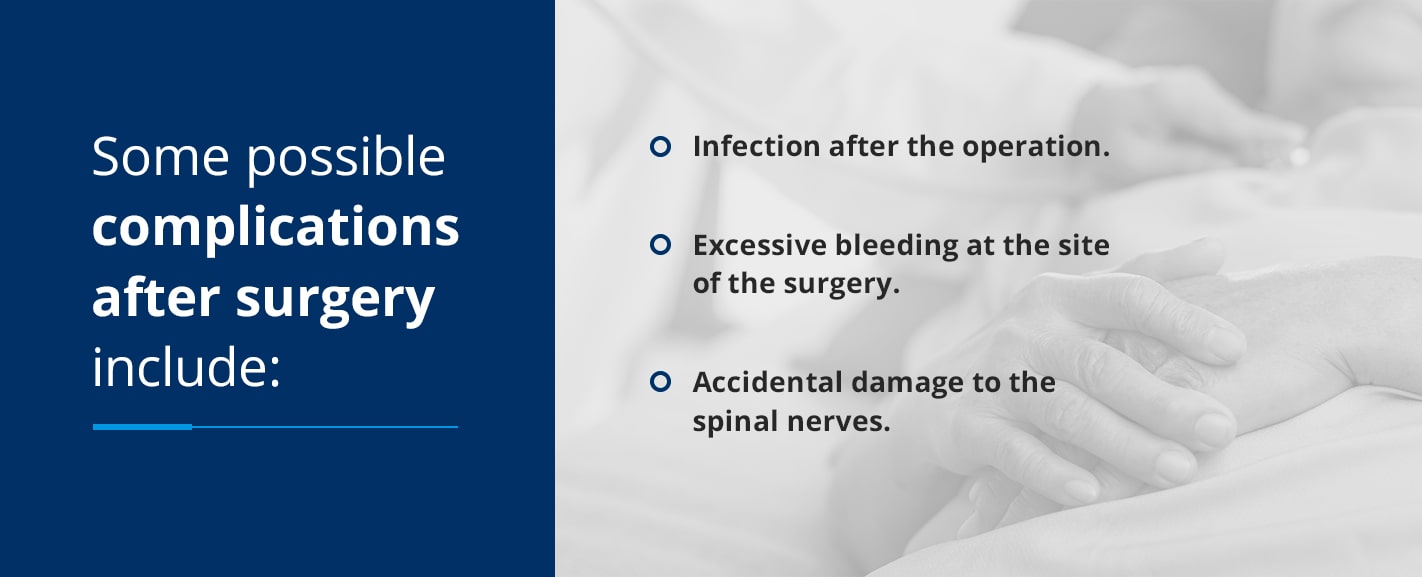
Typically, patients who undergo surgery to fix kyphosis do not experience any complications. However, as with any other surgery, there are risks. Some possible complications include:
- Infection after the operation.
- Excessive bleeding at the site of the surgery.
- Accidental damage to the spinal nerves.
Consult your doctor before proceeding with any surgery to correct kyphosis. Your doctor can explain the benefits and risks to help you determine if spinal fusion surgery is the best for you.
Contact Us for Information About How to Fix Kyphosis
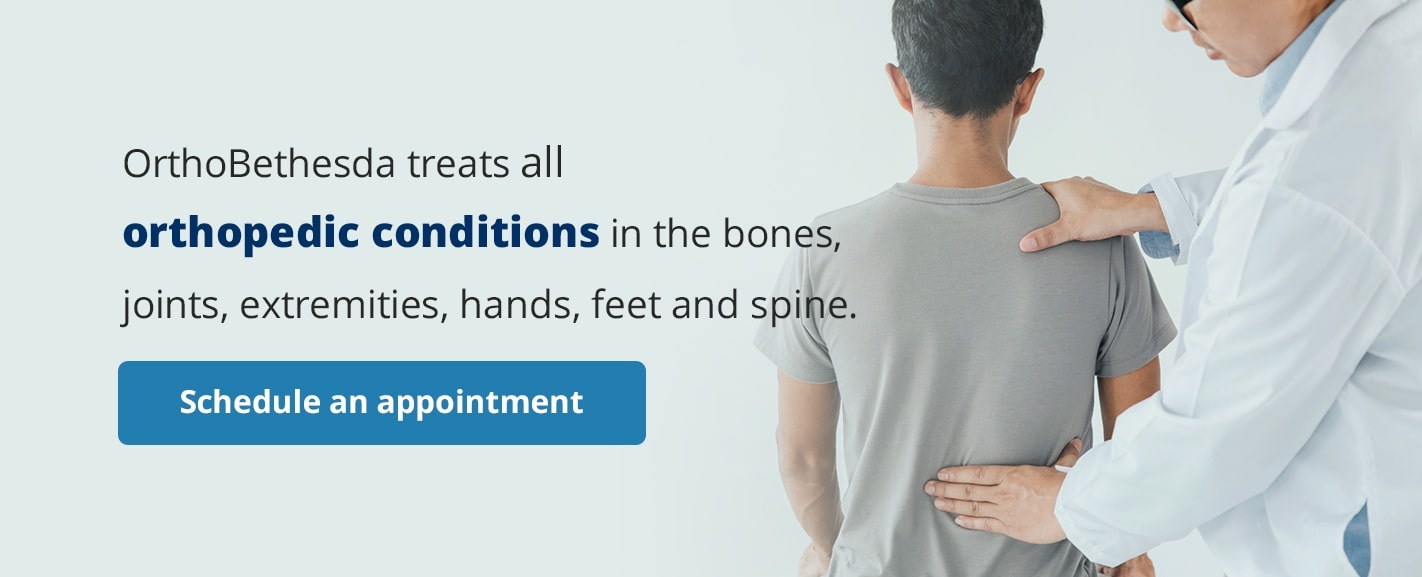
OrthoBethesda treats all orthopedic conditions in the bones, joints, extremities, hands, feet and spine. Specializing in arthritis, fractures and sports-related injuries, we pride ourselves in providing conservative treatment to all our patients. We conduct a thorough evaluation of the ailment and try to provide relief through physical therapy before we recommend any surgeries or injections.
OrthoBethesda established the Washington Spine & Scoliosis Institute in 2017 to treat all orthopedic conditions in the spine, such as kyphosis. Our physicians have a combined 40+ years of experience, giving us the knowledge and credibility to provide top-tier orthopedic treatment. We pride ourselves in providing trusted patient care, paired with our cutting-edge modern technology.
Before prescribing medicine or recommending surgery, we take the time to ensure we give you the best diagnosis and offer the right kind of help. We also offer free patient education, so you have the resources to make the right decisions in taking care of your body. Contact us to find out how we can treat your kyphosis or other orthopedic needs.
Related Content
- How to Prevent Back Pain When Working From Home
- How to Reduce Low Back Pain
- How to Sleep After Back Surgery
- 10 Steps to Achieving Better Posture
- How to Sleep With a Herniated Disc
- How to Know if You Have a Herniated Disc
- Spinal Fusion Surgery – Commonly Asked Questions
- Spine Surgery: When It Works and When It Doesn’t
- Dr. Eric Feuchtbaum Makes Advancements in Minimally Invasive Spine Surgery With Mazor Robotics
- What Causes Sciatica Nerve Pain?
- Everything to Know About Scoliosis
